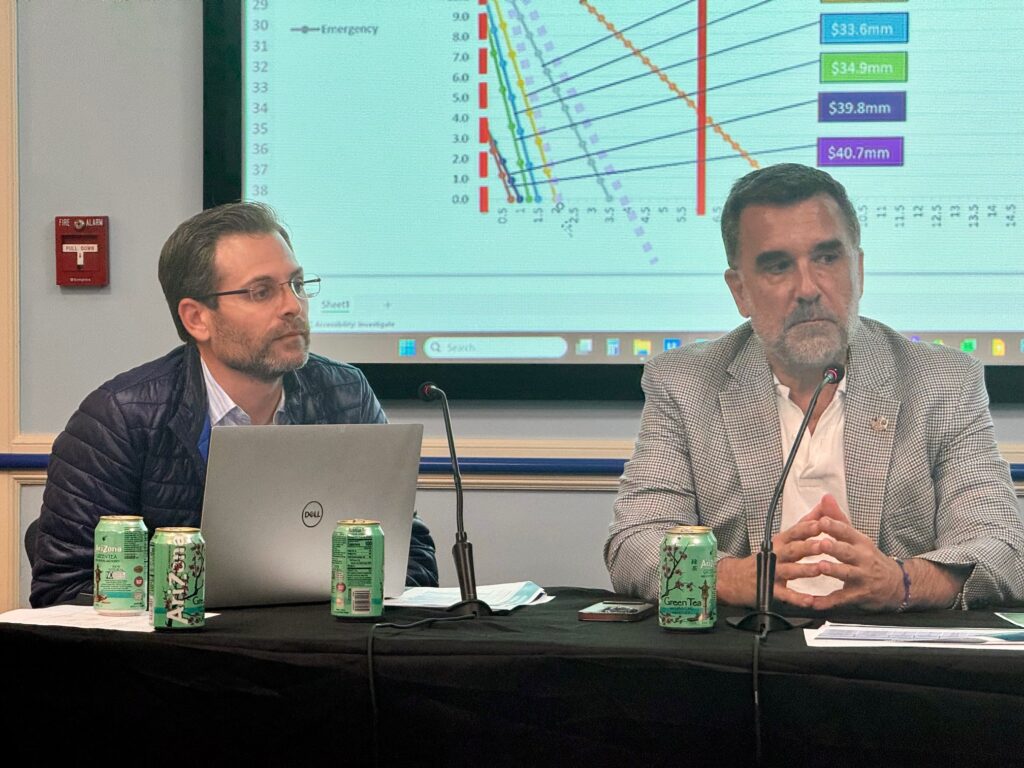The Key Biscayne Village Council Tuesday argued among themselves – for the umpteenth time – about the first phase of the Big Dig’s new stormwater system before approving a $35 million project that was recommended for months by staff and the Village’s own engineers.
The 5-2 decision came after at least five Council workshops, multiple public forums and reams of extra modeling – the latter at taxpayer expense.
Council Members Brett Moss and Ed London voted no, but not before passionate – and sometimes mocking – criticism of the recommended project, arguing it was overkill for climate predictions they believed would either not come to fuition or should just be accepted as the price of living on a barrier island.
The meandering discussion lasted nearly 1½ hours and there were frequent interruptions, but Mayor Joe Rasco did not call any points of order.
“I have to be brutally honest, this was an absolute exercise in futility,” said Council Member Fernando Vazquez, the only environmental engineer on the dais who used to work for the firm that helped design the system.
The project approved does adhere to Miami-Dade guidelines based on rain estimates set by NOAA that could – when pressed – move 2.4 inches of rain off the roadways in an hour and keep them clear in a common storm.
In January, the Council approved a partial work order to complete the design of the system for the flood-prone K-8 neighborhood. However, it took until Tuesday for it to decide on the scope.
Vazquez and the majority defeated a Moss amendment for a scaled back plan. The result is that larger pipes – 48 inches in diameter – will be put in the ground. The bigger pipes can adapt to heavier future rains by adding more pumps – if needed.
The decision could set precedent for all of the Big Dig stormwater system, which is expected to cost around $250 million. The infrastructure project will also bury utility lines and safeguard the coastline at additional costs.
In 2020, Key Biscayne residents voted to give authorization for the Council to borrow up to $100 million via a general obligation bond to help pay for the Big Dig. It will be supplemented with more borrowing from the state and money from the general fund over 30 years.
Tuesday’s vote was a victory for Village Manager Steve Williamson, who has said the recommended system will assure property values by protecting homes for decades to come. It was also a political win for Rasco, who is running for re-election and has promised delivery of the project, which will put shovels in the ground late next year.
Moss, though, proved an unmovable obstacle. He forced an additional workshop and on Tuesday told his colleagues to ignore County standards developed from scientific research. “We are Key Biscayne. There’s no law telling us that we have to be at the level of the County. If the County wants to do it, let them pay for this,” he said.

Moss said his proposal to move 1 inch of water would save about $9 million – but the figure is misleading since it would be paid for and financed over 30 years. The real savings amounts to about $225,000 a year – the Village’s annual cost for the Fourth of July celebration.
“The higher the cost for this project makes it more difficult to do these other projects down the road,” Moss said. “It gets politically more difficult. It gets financially more difficult.”
Roland Samimy, the Village’s chief resilience officer, said installing a system in the ground where residents would experience serious flooding would be a misstep by the Council.
“People, I think, would expect the roads to be clear in a common storm. After making a relatively sizable investment as you’re poised to make and go through the pain of construction, those roads better be clear under a common storm,” he said.
Vazquez said he couldn’t understand why Moss and London were second-guessing the recommendation of the engineering firm the Council hired, AECOM. “I’m not going to sit here and talk about brain surgery,” Vazquez said.
Rasco reiterated Vazquez’s point to Moss: “With all due respect, you’re not an engineer. And why do you think the engineer is recommending something that is so disparate from what you want us to do?”
Moss said it was because the engineers are not “policymakers.”

Council Member Frank Caplan explained to Moss and London the position of the majority. “I think the overarching conundrum that some of us are facing is the penny-wise pound-foolish proposition,” he said.
Rasco tried in vain to push back on Moss – who dominated the March 20 workshop with homemade charts – by showing photos of flooding at his home during a recent deluge. “Why should we not have a system that makes roads dry faster and better?” Rasco asked.
Eventually, Rasco lost parliamentary control as the conversation devolved into Council members simply talking over each other.
In one telling moment, Vice Mayor Allison McCormick, the lone female on the Council, asked an AECOM engineer if his firm benefitted from the Village choosing the more powerful recommended stormwater system.
London interrupted, mansplaining to her that the question should be posed in a way that accused AECOM of unethical gouging. McCormick sat there stonily.
Council Member Oscar Sardiñas, when asked for input, appeared exasperated by the conversation and declined to join in with a “why bother” head shake.
Vazquez also sat there shaking his head. “We can’t design for us, we have to design for prosperity,” he said.
JOHN PACENTI is a correspondent of the Key Biscayne Independent. John has worked for The Associated Press, the Palm Beach Post, Daily Business Review, and WPTV-TV.



